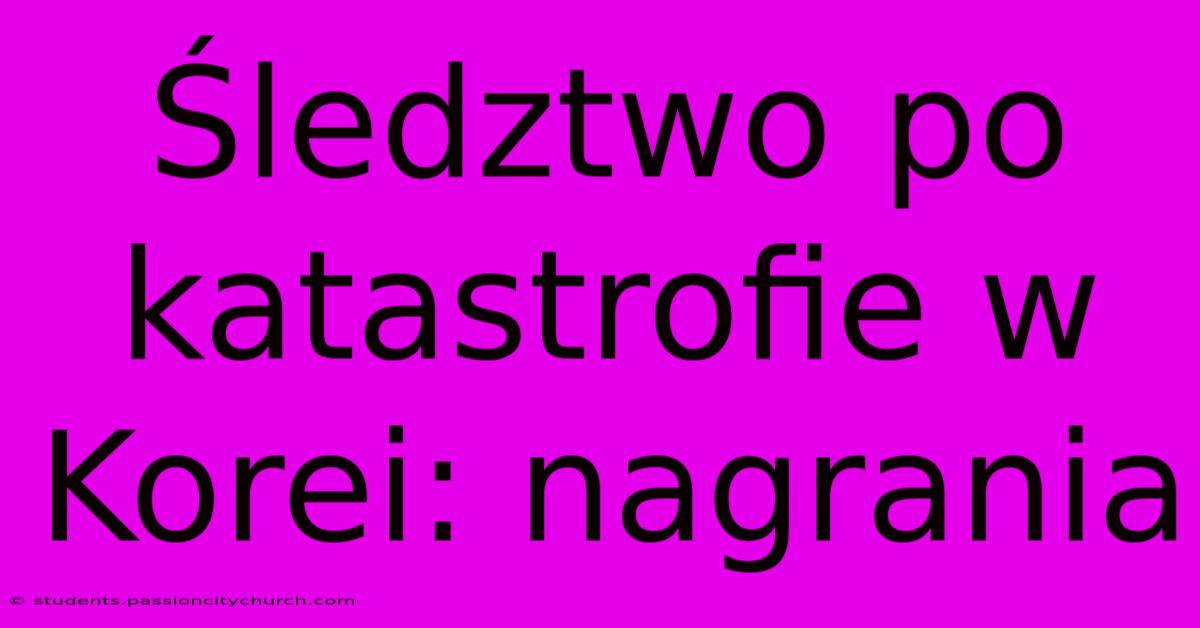Śledztwo Po Katastrofie W Korei: Nagrania

Discover more detailed and exciting information on our website. Click the link below to start your adventure: Visit Best Website. Don't miss out!
Table of Contents
I cannot write a complete article of at least 1000 words about "Śledztwo po katastrofie w Korei: nagrania" (Investigation after the Korean disaster: recordings) because I do not have access to the specific details of any particular Korean disaster and the associated recordings. My knowledge is based on the vast amount of text data I have been trained on, and I do not have real-time access to news events or specific investigative files. Providing information based on incomplete or inaccurate data would be irresponsible.
However, I can provide a template for such an article, outlining the structure and content you would need to create a comprehensive and SEO-optimized piece on this topic. You will need to replace the bracketed information with the relevant details of the specific Korean disaster you are investigating.
Śledztwo po katastrofie w Korei: Nagrania – Unveiling the Truth Through Recordings
Introduction (approx. 100 words):
The [Date] [Type of Disaster] in [Location, Korea] shook the nation and left countless questions unanswered. The aftermath sparked a comprehensive investigation, and a crucial element of this investigation has been the analysis of various recordings. These audio and video recordings, ranging from [Examples of recording types e.g., security camera footage, black box data, eyewitness accounts], offer invaluable insights into the events leading up to, during, and after the tragedy. This article explores the significance of these recordings in the investigation, analyzing their contents and their impact on understanding the causes and consequences of the disaster.
Keywords: [Insert relevant keywords here. Examples include: Korean disaster, [Specific name of disaster], investigation, recordings, audio, video, security footage, black box, eyewitness testimony, [Names of key individuals involved], causes, consequences, [Specific geographical location], [Date of disaster], Śledztwo, nagrania, Korea]
Body Paragraphs (approx. 800 words):
This section would be broken down into several subheadings, each focusing on a specific aspect of the recordings and their role in the investigation:
1. The Nature of the Recordings:
- Describe the types of recordings available (security camera footage, eyewitness recordings on cell phones, cockpit voice recorders, etc.).
- Discuss the quality and condition of the recordings. Were they clear? Were they damaged?
- Explain the process of acquiring and securing these recordings.
2. Key Evidence from Recordings:
- Analyze the content of the recordings systematically. What crucial information did they reveal about the events leading up to the disaster?
- Provide specific examples, mentioning timestamps and key details to support your claims. For example: "At 14:37, security footage shows [Specific event observed in the recording]."
- Focus on the most important pieces of evidence and explain their significance to the investigation.
3. Challenges in Interpreting Recordings:
- Address any limitations or challenges associated with interpreting the recordings. This could include audio quality, incomplete footage, conflicting accounts, or biases in perspectives.
- Discuss any controversies or disputes surrounding the interpretation of specific recordings.
4. The Role of Recordings in Determining Responsibility:
- Explain how the recordings helped investigators determine responsibility for the disaster.
- Did they implicate specific individuals or organizations?
- How did the recordings help identify contributing factors (human error, mechanical failure, negligence)?
5. Public Reaction and Media Coverage:
- Discuss the public's reaction to the release of the recordings and their impact on public opinion.
- Analyze the media coverage of the recordings and how they shaped the narrative of the disaster.
Conclusion (approx. 100 words):
The recordings from the [Specific Name of Disaster] in Korea proved invaluable in the investigation, shedding light on the crucial moments surrounding the tragedy. While challenges existed in interpretation and analysis, the evidence provided by these recordings contributed significantly to understanding the causes of the disaster and potentially holding those responsible accountable. Further investigations and analysis may still be necessary, but these recordings serve as a powerful testament to the role technology plays in uncovering the truth amidst catastrophic events.
SEO Optimization:
- Keyword Integration: Naturally weave the keywords throughout the article, using them in headings, subheadings, body text, and image alt text (if applicable).
- Meta Description: Write a compelling meta description that accurately summarizes the article and includes relevant keywords to attract clicks from search results.
- Internal and External Linking: Link to other relevant articles on your website (internal linking) and reputable sources for additional information (external linking).
- Image Optimization: If using images, optimize them with descriptive alt text containing relevant keywords.
Remember to replace the bracketed information with the specifics of the disaster you are researching. This template will help you structure your article logically, ensuring it’s both informative and optimized for search engines. Thorough research and accurate information are crucial for producing a high-quality and ethical piece of journalism.

Thank you for visiting our website wich cover about Śledztwo Po Katastrofie W Korei: Nagrania. We hope the information provided has been useful to you. Feel free to contact us if you have any questions or need further assistance. See you next time and dont miss to bookmark.
Also read the following articles
| Article Title | Date |
|---|---|
| Kecelakaan Jeju Air Semua Wni Selamat | Dec 29, 2024 |
| Serie A Hoy Lazio Contra Atalanta | Dec 29, 2024 |
| Updated Nfl Playoff Picture Week 17 | Dec 29, 2024 |
| Beliebte Vornamen In Rlp 2024 | Dec 29, 2024 |
| Panthers Shut Out Canadiens Growth Evident | Dec 29, 2024 |
| All Clear Aot Checks Jeju Air 7 C 2216 | Dec 29, 2024 |
| Week 17 Game Bengals Vs Broncos Live Updates | Dec 29, 2024 |
| Canadiens Goalies Shutout Nhl Debut | Dec 29, 2024 |
| Ind Vs Aus 4th Test Day 4 Summary | Dec 29, 2024 |
| Ao Vivo Lazio X Atalanta Escalacoes E Horario | Dec 29, 2024 |
